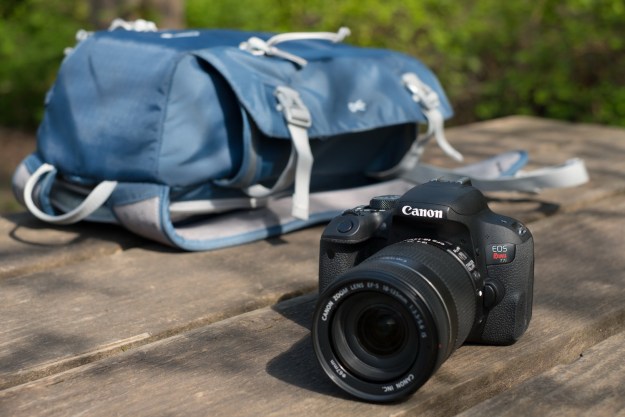Check out our review of the Nikon Df camera.
For you hipsters who love the look of old 35mm film cameras but secretly crave the modern convenience and functionality of a digital shooter, Nikon’s new DSLR, the Df (short for “digital fusion”), offers the high-resolution imaging of a full-frame sensor in a retro-styled body that won’t jeopardize your analog street cred. But, considering the popularity of these classic-looking cameras, the Df simply looks great regardless of whatever subculture you subscribe to.
Of course, the metal construction (magnesium alloy), mechanically clicking dials, and shutter disguise what the Df truly is, a 16.2-megapixel digital camera with an FX-format (full frame) CMOS sensor – the same sensor used in Nikon’s larger-sized D4. You realize it is a digital camera only when you look at the DF from behind. Nikon told us that the DF is designed to deliver the same level of high-quality output as the D4 without all the extra weight and bulk, while paying homage to classic Nikons such as the F, FM, FE, and the F3 (the Df’s grip is modeled after the F3’s); the Df is the smallest, thinnest, and lightest FX-format body, Nikon said. All the often-used photographic settings are readily accessible on top. Other classic cues include the textured surface areas, pentaprism, and top cover. The Df has some weather-resistance properties: the magnesium alloy top back and sides have the same water and dust resistance as the D800, and knobs and dials (shutter speed dial, mode selection, ISO, and EV dials) are also protected from weather. It’s clear that a lot of emphasis has been placed on the construction.
Prior to the unveil Nikon fans were already well aware of this camera, thanks to the rumor sites. But Nikon itself had also been teasing the public with a series of videos that give the hints of something new, something retro. The videos show a well-dressed gentleman, possibly a street photographer or someone who can afford a full-frame camera for a hobby, using a camera with all the sights and sounds of an analog camera – without ever revealing the camera entirely. Whereas a camera like a D4 is designed for work, the Df seems to be all about taking photos for enjoyment. (Is Nikon suggesting that photography was more fun when it was an analog format? Maybe the hipsters are onto something.)
No matter how classic the Df looks and feels, it has Nikon’s latest camera tech inside. That means an Expeed 3 image processor (same as the D4), a 39-point autofocus system, Nikon’s 2,016-pixel “3D Matrix” metering system for automatically determining the best settings for the shooting condition (found in the new D610), ISO range of 100-12,800 (expandable all the way to 204,800 in Hi 4 setting), burst mode of 5.5 frames per second, 3.2-inch LCD (921k dots), spotlight balance (from the D7100), and creative filters. The one modern convenience missing is Wi-Fi, but it’s optional via the WU-1a adapter. The Df is designed purely for photography, so there’s no video recording to be found. The battery is rated at 1,400 shots.
The Df works with a variety of accessories (including all i-TTL Speedlights, as there’s no built-in flash) and lenses, including classic Ai and non-Ai Nikkor glass. But to complement the design, Nikon created a new AF-S Nikkor 50mm f/1.8G Special Edition lens. It has the colors, texture, focus ring, and aluminum mounting ring of classic Nikkor Ai lenses, but the modern lens construction inside, including a seven-blade diaphragm.
So, besides hipsters and rich kids, who else is the Df targeting? Nikon’s Steve Heiner told us that it’s for “someone who is nostalgic [but for a camera] with all the modern convenience, or likes the idea of a classic camera that differentiates from typical crop of DSLRs. It’s evident this thing is quite different. It instills an amount of pride and ownership. When you feel it, it has a unique nostalgic feel.” And when we say rich kids, we aren’t kidding: the Df will sell for $2,750, $3,000 if you opt for the 50mm lens (the lens will be available separately for $280). This is obviously a luxury item designed for someone who loves well-crafted products. As a full-frame camera, it’s half the price of the D4 and easier to tote around, but for the casual photographer full-frame cameras are a big investment. However, the Df has a new contender to deal with and that’s Sony’s new Alpha A7/A7R full-frame mirrorless cameras, which are elegant, compact, and powerful, and start at below $2,000.
Editors' Recommendations
- The best full-frame cameras
- Sony’s new ultra-wide full-frame lens is the first of its kind
- A9, A7R, S, II, or III? Making sense of Sony’s full-frame mirrorless cameras
- Under 1 pound, Sigma Fp is the world’s smallest full-frame camera


